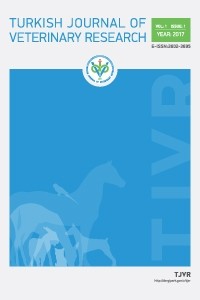
Turkish Journal of Veterinary Research
Yazarlar: Osman Safa TERZİ, Kadir SEVIM, Erfaneh PIRPANAHI, Pınar AMBARCIOGLU, Aybike ALIUSTAOGLU, Ebubekir CEYLAN, Bulent BAS
Konular:Veteriner Hekimlik
Anahtar Kelimeler:Complete blood count,White blood cell,Leucopenia,Neutrophilia
Özet: ABSTRACT Objectives: Interpretation of laboratory data is very important and based on comparison with reference intervals in routine practice. Leukocyte term includes all white blood cells and their precursors. These cells use blood circulation for going to the original tissues from their original locations. Total leukocyte count can be changed by various physiologic and pharmacologic reasons. In healthy cats, lymphocytes are the second most frequent leukocyte in the blood. Compared to middle-aged or old cats, young animals have higher absolute lymphocyte counts. Materials and Methods: The medical records of cats referred to the Ankara University Small Animal Hospital for general examination between April 2016 and August 2017 were retrospectively reviewed. Complete blood count (CBC) data includes red blood cell (RBC) count, haemoglobin, haematocrit (HCT), mean cell volume (MCV), mean cell haemoglobin (MCH), mean cell haemoglobin concentration (MCHC), red blood cell distribution width, platelet count, white blood cell (WBC) count, neutrophils, lymphocytes, monocytes, eosinophils and basophils. Results: Of 5292 cats, 191 cats at the age between 0 and 1 and with CBC data were included in the study. CBCs were obtained from all 191 cats at the first visit. The relationship of hematological data to the reference range is summarized in Table 2. It was observed that 25.7% of the cats had leucocyte counts below the reference interval and 3% had above the reference interval. Considering neutrophil counts, it is seen that 23.3% were lower and 4.5% were higher. According to the results of 191 hemogram tests, lymphocyte counts of 39 cats (19.3%) and monocyte counts of 9 cats (4,5%) were found to be low. Discussion: This is a novel study that includes the results of detailed examination of breed and age distribution of complete blood count results at the first clinical visits of cats. According to our retrospective screening results, it is seen that the relation of monocyte numbers with age is statistically significant. (p = 0.018) The biggest difference between the two age groups in the study is the pre- and post-adolescence periods. It is important to precisely know the results of CBC test in the first visit to the clinic and to take the necessary precautions to eliminate the abnormal results before vaccination.